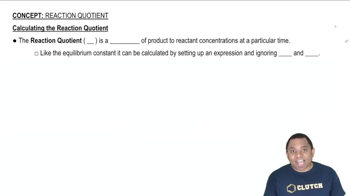At 1000 K, Kp = 2.1 * 106 and ΔH° = - 107.7 kJ for the reaction H21g2 + Br21g2 ∆ 2 HBr1g2.(b) For the equilibrium in part (a), each of the following changes will increase the equilibrium partial pressure of HBr. Choose the change that will cause the greatest increase in the pressure of HBr, and explain your choice.(ii) Adding 0.10 mol of Br2
 Verified step by step guidance
Verified step by step guidance
Verified video answer for a similar problem:
Key Concepts
Le Chatelier's Principle

Equilibrium Constant (Kp)

Reaction Quotient (Q)

Refining petroleum involves cracking large hydrocarbon molecules into smaller, more volatile pieces. A simple example of hydrocarbon cracking is the gas-phase thermal decomposition of butane to give ethane and ethylene: (a) Write the equilibrium constant expressions for Kp and Kc.
Refining petroleum involves cracking large hydrocarbon molecules into smaller, more volatile pieces. A simple example of hydrocarbon cracking is the gas-phase thermal decomposition of butane to give ethane and ethylene: (c) A sample of butane having a pressure of 50 atm is heated at 500 °C in a closed container at constant volume. When equilibrium is reached, what percentage of the butane has been converted to ethane and ethylene? What is the total pressure at equilibrium?
The F-F bond in F2 is relatively weak because the lone pairs of electrons on one F atom repel the lone pairs on the other F atom; Kp = 7.83 at 1500 K for the reaction F2(g) ⇌ 2 F(g). (a) If the equilibrium partial pressure of F2 molecules at 1500 K is 0.200 atm, what is the equilibrium partial pressure of F atoms in atm?
